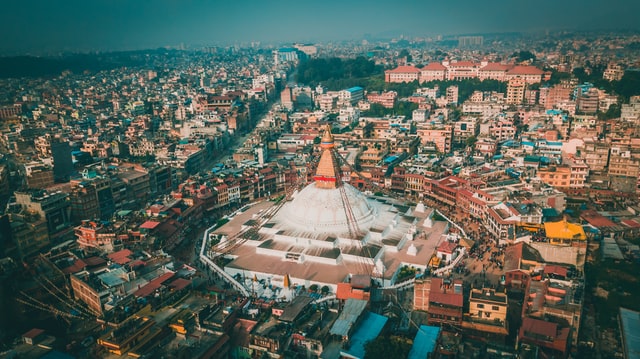Nepal is a landlocked country in South Asia. A mostly mountainous country, Nepal is ethnically and linguistically diverse with so much to explore and experience. Here are 21 interesting facts about Nepal, “the land of the Himalayas”.
21 interesting facts about Nepal
1. Overview


The country of Nepal has an area of 147,516 square kilometers and a population of about 28 million. Nepal borders Tibet (China) in the north and India in the west, east, and south. Nepal is officially known as the Federal Democratic Republic of Nepal.
2. Home of the Himalayas

A major part of the Himalayan mountain range lies in Nepal. The Himalayan range has shaped the culture of Nepal and is a major driver of the country’s economy.
3. Mount Everest is in Nepal

8 of the top 10 highest mountain peaks in the world are in Nepal, including the highest, Mount Everest. Mount Everest, also known as Sagarmāthā, has an elevation of 8,848.86 m (29,031.7 ft) and is located on the Nepal-China border in the Mahalangur Himal, a section of the Himalayas.
High mountain peaks of Nepal
- Mount Everest (World ranking – 1) – 8,848.86 m (29,031.7 ft)
- Kangchenjunga (World ranking – 3) – 8,586 m (28,169 ft)
- Lhotse (World ranking – 4) – 8,516 metres (27,940 ft)
- Makalu (World ranking – 5) – 8,463 m (27,766 ft)
- Cho Oyu (World ranking – 6) – 8,188 m (26,864 ft)
- Dhaulagiri (World ranking – 7) – 8,167 m (26,795 ft)
- Manaslu (World ranking – 8) – 8,163 m (26,781 ft)
- Annapurna I (World ranking – 10) – 8,091 m (26,545 ft)
4. Flag of Nepal

The flag of Nepal is the only non-quadrilateral flag among all sovereign nation flags.
5. The Birthplace of Gautama Buddha
Gautama Buddha, the founder of Buddhism was born in Lumbini, Nepal. Lumbini is among the four primary pilgrimage sites for Buddhists.

The four primary pilgrimage sites for Buddhists-
- Lumbini – the birthplace of Gautama Buddha
- Bodh Gaya – the place where Gautama Buddha attained enlightenment.
- Sarnath – the place where Buddha delivered his first sermon
- Kushinagar – the place where Buddha attained Parinirvana
6. Geographical Regions of Nepal
Nepal has three geographical regions-
- The mountain region (Greater Himalayas)
- The hilly region (lower and middle Himalayas)
- The Terai region (fertile lowlands, mostly plains south of the Himalayas)
7. Nepal was under Monarchy until 2008
On 28 May 2008, the monarchy was abolished in Nepal. Nepal then became a Federal Democratic Republic. The current constitution of Nepal came into effect on 20 September 2015 after years of turmoil.
8. Never Occupied
Nepal is among the very few countries in the world that have never been colonized.
9. The Annapurna peak

The Annapurna peak (8,091 m/26,545 ft) is considered the most dangerous mountain peak to climb in the world. The climb to the summit of the 10th highest peak in the world is often accompanied by unpredictable weather and avalanches.
10. Languages of Nepal

Nepali is the official language of Nepal. It is written in Devanagiri script similar to Hindi and Sanskrit. Apart from Nepali, there are 122 other major languages in Nepal.
11. A trekking Paradise

Nepal is a paradise for trekking enthusiasts. Treks like the Annapurna circuit trek, Annapurna base camp trek, Everest three passes trek, etc are among the most popular treks in the world.
12. Biking adventures in Nepal

Not just trekking, Nepal is also a prime destination for biking and Motorcycling adventures.
13. Cow – the national animal

The National animal of Nepal is Cow. The cow has constitutional protection in Nepal and the slaughter is completely banned.
14. Indian Rhinoceros

Nepal is home to the second-largest population of the Great Indian one-horned Rhinoceros. There are currently (in 2022) 700-800 Rhinos living in the wild in Nepal mainly in Chitwan National Park and Bardiya National Park.
15. Some other Charismatic megafauna of Nepal

Nepal is also home to 200-300 Bengal Tigers and around 200 wild Elephants. In the upper reaches of the Nepal Himalayas, the snow leopard and the Himalayan wolf are also seen.
16. Tourism in Nepal
The tourism industry is one of the largest contributors to Nepal’s economy. It is the fourth largest industry in the country by employment. The majority of tourists coming to Nepal are from India, China, and United States.
17. Provinces in Nepal
There are 7 provinces in Nepal.
- Province 1
- Madhesh Province
- Bagmati Province
- Gandaki Province
- Lumbini Province
- Sudurpashchim Province
- Karnali Province
18. Capital of Nepal

The capital of Nepal is Kathmandu. Kathmandu has a population of about 850,000, making it the most populous city in Nepal. The city lies in the Kathmandu Valley which is a UNESCO World Heritage Site.
19. Religion in Nepal

The majority population in Nepal follows Hinduism. As per the last census, 81.3 % population in Nepal follows Hinduism. 9.04 % population follows Buddhism, 4.39% follow Islam, and 3.04% follow Kirat Mundhum.
20. UNESCO World Heritage Sites in Nepal
There are currently 4 UNESCO World Heritage Sites in Nepal- 2 cultural and 2 natural.
Cultural World Heritage sites in Nepal-
- Kathmandu valley
- Lumbini, the Birthplace of the Lord Buddha
Natural World Heritage sites in Nepal-
- Chitwan National Park
- Sagarmatha National Park
21. Rivers in Nepal

The mountains of Nepal are the origin of many important rivers of Nepal and India. Major rivers like Girwa, Kauriala, Gandaki, Koshi, etc originate in Nepal. These rivers are also the major tributaries of the Ganga.
Some basic facts about Nepal
| National Animal | Cow |
| National bird | Himalayan Monal |
| National sport | Volleyball |
| National flower | Rhododendron |
| Area | 147,516 square kilometers |
| Population | about 28 million |
| Bordering countries | India and China |
| Largest city and capital | Kathmandu |
Read more
Annapurna circuit trek is what I wanna do…🏔